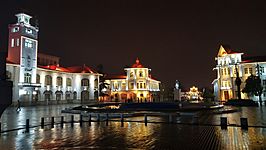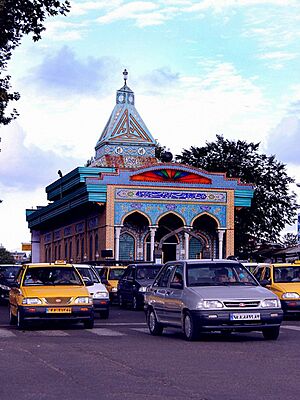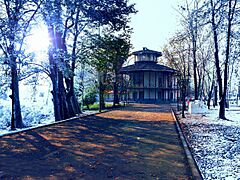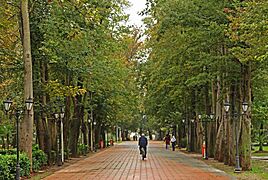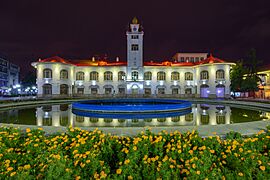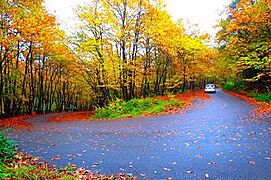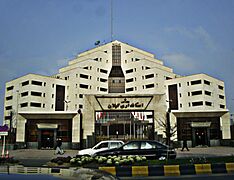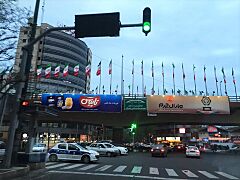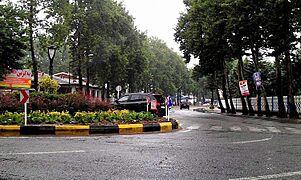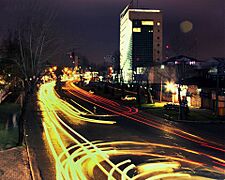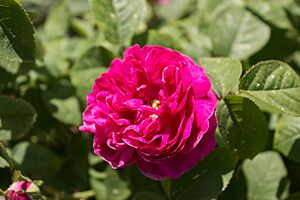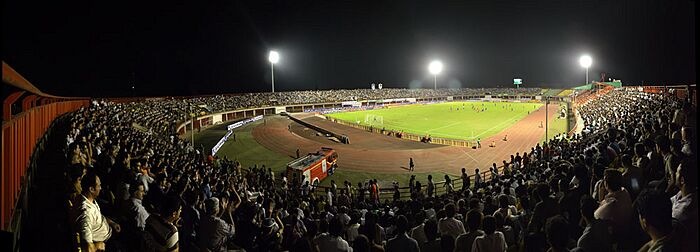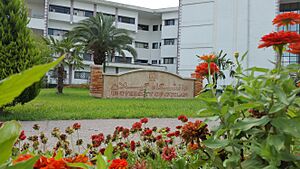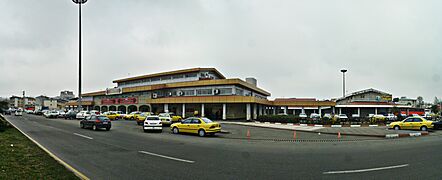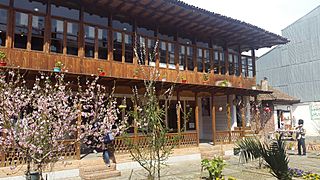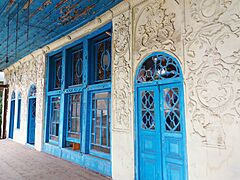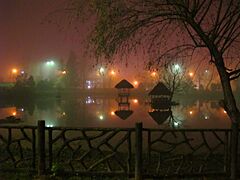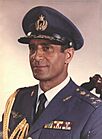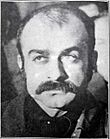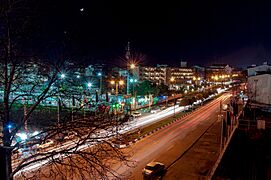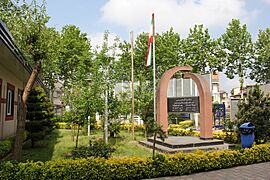Rasht facts for kids
Quick facts for kids
Rasht
|
|
|---|---|
|
City
|
|
|
Municipal hall at night, Mirza Koch tomb, Saint Mesrop Church, Kolah Farangi mansion, Gilan Rural Heritage Museum, Gulzar bath, National library.
|
|
| Nicknames:
Rain City, Rasht-Heaven
|
|
| Country | Iran |
| Province | Gilan |
| County | Rasht |
| District | Central |
| Area | |
| • Total | 95 km2 (37 sq mi) |
| Population
(2016)
|
679,995 |
| • Population Rank in Iran | 11th |
| Time zone | UTC+3:30 (IRST) |
| Area code(s) | 013 |
Rasht (Persian: رشت) is a big city in the Gilan province of Iran. It is the capital city for the province, county, and district. People often call Rasht the "City of Rain" because it gets a lot of rain. In 2016, about 680,000 people lived there, making it the biggest city in northern Iran.
Rasht is the largest city along Iran's Caspian Sea coast. It's located between the coast and the mountains. This special location gives it a very rainy and humid climate. It even has temperate rainforests nearby, which is unusual for mostly dry Iran.
The city is an important place for trade between Caucasia, Russia, and Iran. It uses the port of Bandar-e Anzali for this trade. Rasht is also a popular spot for tourists. People visit the mountain resort of Masouleh and enjoy the beaches of the Caspian Sea.
Historically, Rasht was a key link between Iran, Russia, and Europe. This is why it was known as the "Gate of Europe." Its history goes back to the 13th century. But it became very important during the Safavid era as a major center for silk trade. Many workshops there made textiles. In 2015, UNESCO recognized Rasht as a creative city for its amazing food.
Some well-known neighborhoods in Rasht are Golsar, Safsar, Kordmahaleh, and Khamiran.
Contents
What's in a Name?
There are a few ideas about where the name "Rasht" comes from:
- Some say it comes from the word resh (رش). This word means very light rain in Persian. The Gilaki word Varesh (وارش), meaning "rain," might be a mix of Va + resh.
- Another idea is that the correct name is Resht (رِشت). This could come from Risidan (ریسیدن) or Reshtan (رشتن), both meaning to spin. This name would make sense because the city was famous for making silk threads.
Rasht's Past
Rasht was first mentioned in old documents in 682 CE. But it is likely much older than that. The city has seen many different rulers and events. These include the Sassanid era, the Rashidun Caliphate, and armies from Peter the Great. The people of Rasht also played a big part in Iran's Constitutional Revolution of Iran.
Key Moments in History
- 682: Rasht is first mentioned in historical papers.
- 1669: A Cossack leader named Stenka Razin attacked the city.
- 1714: An earthquake destroyed parts of Rasht.
- 1722–1732: Russian forces took over Rasht during a war.
- 1901: A serious disease spread through the city.
- 1917–1920: Russian and British armies fought near Rasht. The Russians then took control.
- 1920–1921: The Persian Socialist Soviet Republic was set up in Rasht for a short time.
- 1937: A revolt over a "road tax" was stopped.
- 1974: The first university in Rasht was built.
Rasht was one of the first cities in Iran to have factories in the late 1800s. These factories worked on things like fishing, making caviar, and textiles. Until the mid-1970s, Gilan and Rasht were the third most industrial areas in Iran. They had many workers and produced a lot.
The people of Rasht were very important in starting the Persian Constitutional Revolution (1905–1907). Mīrzā Kūchak Khān, a famous leader of this revolution, was born in Rasht. His group, called the Jangalis, wanted modern changes for Muslim traditions. Mirza even started the short-lived Persian Socialist Soviet Republic in 1920.
This republic had help from the Russian Red Army. But the Soviet Government later stopped its support. The republic also faced problems from within, between different groups. In the end, the Iranian army defeated the republic.
Rasht was home to Iran's first national library, built during the Qajar dynasty. The first modern newspaper in Iran, Nasim-e-Shomal, was first printed in Rasht. The city also had Iran's first public library, first 24/7 pharmacy, first school for girls, and first fire station. Rasht was truly a center of new things in Iran.
During the Qajar period, trade between Iran and Russia grew. Rasht became the main way to get to Europe in the 1800s. A Russian writer named Grigoriy Melgunov visited Rasht in 1860. He wrote that the city had many houses, shops, mosques, schools, and bathhouses. It had a population of over 27,000 people. At that time, Russia, Britain, and the Ottoman Empire even had offices in Rasht.
Rasht Today
Rasht is becoming a modern industrial city, like many other large cities in Iran. It has the Kadus International Hotel and many other attractions. Thousands of tourists visit Rasht every year. They come from countries like Austria, Germany, France, and Japan.
The city is known for its beautiful municipal building in Municipality Square. It was built around 1900 and is updated every year. Because of the high humidity, old buildings in Rasht can get damaged. So, newer, taller buildings are slowly replacing the older ones.
People in Rasht enjoy shopping and cultural activities. The city has a long history of trade and connections with Europe. This means people there are familiar with modern developments. Many banks and financial companies have offices in Rasht. They often build attractive, modern buildings for their branches.
Since the Islamic Revolution in 1979, banks from Russia, Turkey, and Azerbaijan have wanted to open branches in Rasht. This is another reason why the city is called the "gate of Europe" in Iran. The Russian government has a main office in Rasht. Other countries near the Caspian Sea also want to set up offices there.
For example, the University of Gilan was built about 40 years ago with help from Iran and West Germany. The building for the IRIB (Iran's broadcasting company) in Rasht was built by Iranian and Belgian engineers.
-
Bigler-Beigi Pavilion, from Qajar dynasty
Rasht: First in Iran
Rasht holds many "firsts" in Iran's history:
- The first branch of Bank Sepah, Iran's first bank, opened in Rasht in 1925.
- The first school for girls in Iran was started here.
- The first 24/7 pharmacy in Iran was in Rasht.
- The first place for elderly and disabled people to get care was in Rasht.
- The first National Library of Iran was built in Rasht in 1920.
- The first bus in Iran arrived in Rasht.
- It was the first city to have a sewage system.
- It was the first city where Russian, British, French, and Ottoman governments opened their offices.
- The first silk factory in Iran was here.
- The first national hospital in Iran, Poursina Hospital, was in Rasht.
- The first classical theater in Iran was also in Rasht.
Streets and Roads
- Golsar Street
- Imam Ali Boulevard
- Shahid Chamran Boulevard
- Ayatollah Taleghani Boulevard
- Resalat Street
- Shohaday-e Gomnam Boulevard
- Ostadsara Street
- Esteghamat Street
- Deylaman Boulevard
- Moallem Boulevard
- Imam Khomeini Boulevard
- Valiasr Street
- Enghelab Street
- Azadi Street
- Azadegan Boulevard
- Shahid Ansari Street
- Farhang Street
- Parastar Boulevard
- Bastani Shoaar Street
- Afakhra Street
- Pasdaran Street
- 22 Bahman Boulevard
- Alamolhoda Street
- Saadi Street
- Tohid Street
- Navab Street
- Gilan Boulevard
- Gholipour Boulevard
- Habibzadeh Boulevard
- Ansari Boulevard
- Suleman Darab Boulevard
- Takhti Street
- Bisotun Street
Weather in Rasht
Rasht has a humid subtropical climate. This means it gets a lot of rain. It is one of the wettest places in Iran. Summers are warm, and winters are cool, sometimes with snow. The air is usually very humid, over 80%. This is very different from most other parts of Iran. Rasht is truly known as "The City of Rain."
| Climate data for Rasht, (normals and extremes 1991-2020) | |||||||||||||
|---|---|---|---|---|---|---|---|---|---|---|---|---|---|
| Month | Jan | Feb | Mar | Apr | May | Jun | Jul | Aug | Sep | Oct | Nov | Dec | Year |
| Record high °C (°F) | 27.5 (81.5) |
29.8 (85.6) |
38.0 (100.4) |
37.4 (99.3) |
38.6 (101.5) |
35.2 (95.4) |
36.6 (97.9) |
38.4 (101.1) |
40.0 (104.0) |
37.4 (99.3) |
32.3 (90.1) |
29.2 (84.6) |
40.0 (104.0) |
| Mean daily maximum °C (°F) | 11.6 (52.9) |
11.5 (52.7) |
14.7 (58.5) |
19.1 (66.4) |
24.4 (75.9) |
28.5 (83.3) |
30.5 (86.9) |
30.9 (87.6) |
27.2 (81.0) |
22.8 (73.0) |
17.0 (62.6) |
13.3 (55.9) |
21.0 (69.7) |
| Daily mean °C (°F) | 7.1 (44.8) |
7.0 (44.6) |
9.7 (49.5) |
14.0 (57.2) |
19.6 (67.3) |
23.8 (74.8) |
25.7 (78.3) |
25.7 (78.3) |
22.3 (72.1) |
17.9 (64.2) |
12.5 (54.5) |
8.9 (48.0) |
16.2 (61.1) |
| Mean daily minimum °C (°F) | 3.8 (38.8) |
3.9 (39.0) |
6.6 (43.9) |
10.5 (50.9) |
15.9 (60.6) |
19.8 (67.6) |
21.8 (71.2) |
21.7 (71.1) |
19.0 (66.2) |
14.6 (58.3) |
9.3 (48.7) |
5.6 (42.1) |
12.7 (54.9) |
| Record low °C (°F) | −11.6 (11.1) |
−9.0 (15.8) |
−2.1 (28.2) |
−0.2 (31.6) |
3.8 (38.8) |
12.1 (53.8) |
14.8 (58.6) |
14.8 (58.6) |
11.5 (52.7) |
7.8 (46.0) |
−3.6 (25.5) |
−3.5 (25.7) |
−11.6 (11.1) |
| Average precipitation mm (inches) | 131.4 (5.17) |
131.6 (5.18) |
108.3 (4.26) |
73.1 (2.88) |
41.5 (1.63) |
41.7 (1.64) |
52.3 (2.06) |
71.8 (2.83) |
159.3 (6.27) |
200.4 (7.89) |
218.2 (8.59) |
153.2 (6.03) |
1,382.8 (54.43) |
| Average extreme snow depth cm (inches) | 6.09 (2.40) |
4.46 (1.76) |
0.62 (0.24) |
0.0 (0.0) |
0.0 (0.0) |
0.0 (0.0) |
0.0 (0.0) |
0.0 (0.0) |
0.0 (0.0) |
0.0 (0.0) |
0.53 (0.21) |
0.6 (0.2) |
6.09 (2.40) |
| Average precipitation days (≥ 1 mm) | 10 | 10.2 | 10.1 | 7.3 | 6.2 | 4.1 | 3.9 | 5.9 | 8.7 | 10.4 | 11.3 | 9.9 | 98 |
| Average relative humidity (%) | 85 | 85 | 84 | 82 | 80 | 77 | 77 | 79 | 84 | 87 | 88 | 86 | 83 |
| Average dew point °C (°F) | 4.2 (39.6) |
4.1 (39.4) |
6.7 (44.1) |
10.5 (50.9) |
15.6 (60.1) |
19.2 (66.6) |
21.1 (70.0) |
21.4 (70.5) |
19.4 (66.9) |
15.5 (59.9) |
10.2 (50.4) |
6.2 (43.2) |
12.8 (55.1) |
| Source: NOAA IRIMO(snow depth 2004-2023) | |||||||||||||
| Climate data for Rasht (1956-2010, records 1956-2020) | |||||||||||||
|---|---|---|---|---|---|---|---|---|---|---|---|---|---|
| Month | Jan | Feb | Mar | Apr | May | Jun | Jul | Aug | Sep | Oct | Nov | Dec | Year |
| Record high °C (°F) | 30 (86) |
31 (88) |
38.0 (100.4) |
37.4 (99.3) |
38.6 (101.5) |
37 (99) |
37 (99) |
38.4 (101.1) |
40 (104) |
37.4 (99.3) |
36 (97) |
32 (90) |
40 (104) |
| Mean daily maximum °C (°F) | 11.0 (51.8) |
11.2 (52.2) |
13.5 (56.3) |
19.0 (66.2) |
24.0 (75.2) |
28.1 (82.6) |
30.3 (86.5) |
30.2 (86.4) |
26.7 (80.1) |
22.1 (71.8) |
17.5 (63.5) |
13.5 (56.3) |
20.6 (69.1) |
| Daily mean °C (°F) | 6.7 (44.1) |
7.0 (44.6) |
9.4 (48.9) |
14.3 (57.7) |
19.2 (66.6) |
23.2 (73.8) |
25.3 (77.5) |
25.3 (77.5) |
22.2 (72.0) |
17.7 (63.9) |
12.9 (55.2) |
8.9 (48.0) |
16.0 (60.8) |
| Mean daily minimum °C (°F) | 2.4 (36.3) |
2.7 (36.9) |
5.3 (41.5) |
9.6 (49.3) |
14.4 (57.9) |
18.2 (64.8) |
20.4 (68.7) |
20.3 (68.5) |
17.6 (63.7) |
13.3 (55.9) |
8.3 (46.9) |
4.4 (39.9) |
11.4 (52.5) |
| Record low °C (°F) | −19 (−2) |
−18 (0) |
−6.4 (20.5) |
−2 (28) |
3.6 (38.5) |
5 (41) |
11 (52) |
9 (48) |
7 (45) |
1 (34) |
−4 (25) |
−10 (14) |
−19 (−2) |
| Average precipitation mm (inches) | 132.4 (5.21) |
116.0 (4.57) |
112.5 (4.43) |
64.8 (2.55) |
51.5 (2.03) |
43.0 (1.69) |
42.3 (1.67) |
68.4 (2.69) |
152.5 (6.00) |
211.5 (8.33) |
186.8 (7.35) |
155.8 (6.13) |
1,337.5 (52.65) |
| Average precipitation days | 13.4 | 12.9 | 15.4 | 12.3 | 10.9 | 7.3 | 6.3 | 8.6 | 12.0 | 13.8 | 12.8 | 13.0 | 138.7 |
| Average snowy days | 2.5 | 2.8 | 1.3 | 0.1 | 0.0 | 0.0 | 0.0 | 0.0 | 0.0 | 0.0 | 0.1 | 0.9 | 7.7 |
| Average relative humidity (%) | 84 | 85 | 84 | 80 | 78 | 74 | 74 | 77 | 82 | 86 | 85 | 85 | 81 |
| Average afternoon relative humidity (%) | 77 | 77 | 75 | 69 | 66 | 63 | 63 | 65 | 71 | 75 | 76 | 77 | 71 |
| Average dew point °C (°F) | 3.8 (38.8) |
4.0 (39.2) |
6.3 (43.3) |
10.5 (50.9) |
15.3 (59.5) |
18.8 (65.8) |
20.7 (69.3) |
21.0 (69.8) |
19.0 (66.2) |
15.2 (59.4) |
10.4 (50.7) |
6.2 (43.2) |
12.6 (54.7) |
| Mean monthly sunshine hours | 91.7 | 86.7 | 91.2 | 122.0 | 174.0 | 213.2 | 222.1 | 187.7 | 140.2 | 118.3 | 100.2 | 89.6 | 1,636.9 |
| Source: Shahrekord Meteorology Database | |||||||||||||
People of Rasht
How Many People Live Here?
| Historical population | ||
|---|---|---|
| Year | Pop. | ±% p.a. |
| 1986 | 290,897 | — |
| 1996 | 417,748 | +3.69% |
| 2006 | 551,161 | +2.81% |
| 2011 | 639,951 | +3.03% |
| 2016 | 679,995 | +1.22% |
| source: | ||
Rasht is the most populated city in northern Iran. In 2006, about 551,000 people lived there. By 2016, the population grew to nearly 680,000 people.
What Language Do They Speak?
Most people in Rasht are Gilaks. They make up about 98% of the population. They speak a local language called Gilaki, specifically the Rashti version of Western Gilaki.
Rasht's Culture
People in Rasht enjoy arts, good food, and fashion. They like to spend their free time at cinemas, art shows, music concerts, and book fairs. The city also holds sports, cultural, and tech contests for young people. A popular event is the yearly blogging competition for young bloggers.
Rasht has been very important in Iranian history. It was Iran's main connection to Russia and Europe. Because of this, it was influenced by Western buildings and ideas. Iran's first public library was built here. It was also the first city in Iran where girls could go to school.
In 2015, UNESCO added Rasht to its Creative Cities Network. This was because of its unique and delicious food. Rasht embroidery is also a special art form from the city and Gilan province.
January 4th is celebrated as Rasht Day. This date marks when Rasht became the political center of Gilan over 4,500 years ago.
Delicious Food
The people of Rasht love to eat different kinds of fish. Other popular local dishes include Mirza Ghassemi, vavishka (a type of stew), nargesi, baghala ghatogh, and ashpal (fish eggs). Reshteh khoshkar is a well-known sweet treat. Zeitoun Parvardeh, made from olives and pomegranates, is a popular side dish.
The Rose of Rasht
The Rosa 'de Rescht' is a special type of rose. It has an interesting history. This rose first came from Iran. It was known in England in the late 1800s but then forgotten.
In 1945, a woman named Miss Nancy Lindsay found it again near Rasht. She brought it back to the United Kingdom. Today, this rose is famous and wins many awards.
Sports in Rasht
People in Rasht are big fans of football. The city's favorite teams are Damash Gilan and Sepidrood Rasht. Damash Gilan used to be called Pegah football club. It was bought by a water company and changed its name.
Damash Gilan plays at Dr. Azodi Stadium. This stadium is about 40 years old and can hold 11,000 people. Sardar Jangal Stadium is the city's second stadium.
After football, wrestling, judo, and weightlifting are very popular with young people in Rasht. This is because Iranian wrestlers and weightlifters have done very well in big competitions like the Olympics. Hossein Rezazadeh, a famous weightlifter who won two Olympic gold medals, inspires many young people in Rasht. Asghar Ebrahimi, who led Iran's weightlifting team in the 2008 Olympics, is also from Rasht.
Learning in Rasht
Rasht has many colleges and universities:
- University of Gilan
- Gilan university of medical sciences
- Islamic Azad University of Rasht
- Jaber ebn Hayyan Institute of Higher Education
- Payame Noor University
- Institute of Higher Education for Academic Jihad of Rasht
- Guilan Technical & Vocational Training Organization
- Gilan Advanced Skills Training Center
- Rasht Technical and Vocational Institute
- Guilan University of Applied and Scientific Technology
Rasht's Economy
Rasht is very important because of its location. It's on a wide, fertile plain, great for growing rice. It's also a key point for roads connecting Tehran, Qazvin, Anzali, and Astara. As the capital of Gilan province, it has grown with many factories and businesses. This has led to more farming, trade, and science centers.
Most people in Rasht work in services, trade, and industry. In the villages around Rasht, growing rice is the main activity.
For a long time, Rasht was a major customs city in Iran. It was the only way for Iran to trade with Europe through the Anzali port. From the time of Shah Abbas II until the end of the Qajar rule, Rasht was a big trading hub. Caravans would stop here to buy silk and sell their goods.
The presence of Russian and British offices in Rasht helped the city's economy grow. Many people in Rasht became very wealthy during the Qajar period. Today, Rasht has many shopping centers and banks. These include branches of the Exports Development Bank of Iran.
Medicine and Drugs
Rasht has a Faculty of Pharmacy at the Gilan University of Medical Sciences. It also has several places that make medicines. One of these makes special anti-cancer drugs. Sobhan Daroo Co. is one of Iran's most successful drug companies. It is the second largest producer in the country. Sobhan Oncology Pharmaceutical Company makes modern anti-cancer products.
Getting Around Rasht
Taxis
In 1947, 50 taxis were bought from England for Iran. In 1948, the first taxi arrived in Rasht. Today, Rasht has over 9,500 taxis and private cars for hire.
Trains
Rasht has a railway station south of the city. The railway goes through the Alborz mountains and the Sefidrood river valley. It connects to Karaj and Qazvin on its way to Tehran. To the north, the railway goes to the Anzali free trade zone.
International Airport
The Rasht International Airport is the only airport in Gilan province. It opened in 1969 and covers about 220 hectares. At first, it only had flights to Tehran and Mashhad. But after it was renamed Sardar Jangal International Airport in 2007, more routes were added.
The airport now has hundreds of flights each year. Many airlines use it, including Mahan Air, Iran Air, and Kish Air. It handles over 2,000 flights every year.
Fun Places to Visit
Rasht has many interesting historical sites and beautiful natural spots:
- Municipal Complex
- Iran Hotel
- Post Building
- National Library
- Tomb of Mirza Kuchak Khan
- Mirza Kuchak Khaan House
- Safi Mosque
- Kolah Farangi Mansion
- Sabzeh Meydan Park
- Gilan Rural Heritage Museum
- Saravan Forest Park
- Rasht Museum of Anthropology
- Avanesian House
- Rasht Grand Market
- Hajj Samad Khan Mosque
- Haj Samiee Mosque
- Badyollah Mosque
- Qadiri House of Rasht
- Mirza Khalil House
- Governor's Building
- Mohtasham Garden
- Mafakher Park
- Emamzadeh Hashem
- Imamzadeh Ismail and Abbas
- Mellat Park
- Eynak Lagoon
- Keshavarz Park
- Meshkat Park
- Towhid Park
- Golshan Mosque
- Kase Forushan Mosque
- Zargaran Mosque
- Abrishamchi House
- Ashkouri House
- Seyyed Ali Moghimi House
- Mohtasham Caravanserai
- Haji Bath
- Ebrahim Pourdavoud Tomb
- Chomarsara Clay Bridge
- Gishe Damerdeh Bridge
- Gurab-e Lishavandan
- Tomb of Imam's sister
- Imamzadeh Bibi Zeynab
- Tomb Tower Danaye Ali
- Siah Estalakh Village
- Lat Carvansary
- Shahid Beheshti High School
Famous People from Rasht
Many well-known people come from Rasht, including:
- Hushang Ebtehaj (1928–2022) – a famous poet.
- Mirza Kuchik Khan (1880–1921) – a revolutionary leader.
- Aydin Aghdashloo (born 1940) – a painter and artist.
- Majid Samiei – a top brain surgeon.
- Mahmoud Namjoo (1918–1989) – a weightlifter.
- Marjane Satrapi (born 1969) – a graphic novelist and film director.
- Susan Taslimi (born 1950) – an actress.
- Asghar Ebrahimi – an Iranian weightlifter.
- Mohammad Tolouei – a writer.
- Shohreh Bayat (born 1987) – a chess referee.
How Far is Rasht from Other Cities?
| City | Distance in Kilometers |
|---|---|
| Isfahan | 640 |
| Tehran | 326 |
| Kerman | 1250 |
| Mashhad | 1063 |
| Tonekabon | 137 |
| Amol | 295 |
| Shahrekord | 739 |
| Ahvaz | 956 |
Partner Cities
Rasht has special partnerships with these cities:
See also
 In Spanish: Rasht para niños
In Spanish: Rasht para niños


